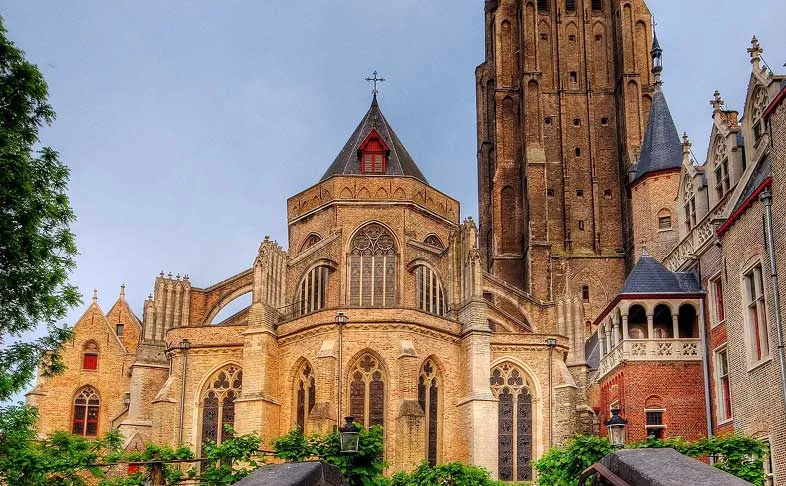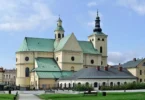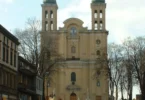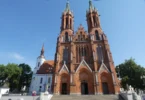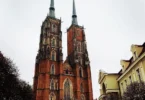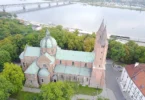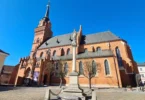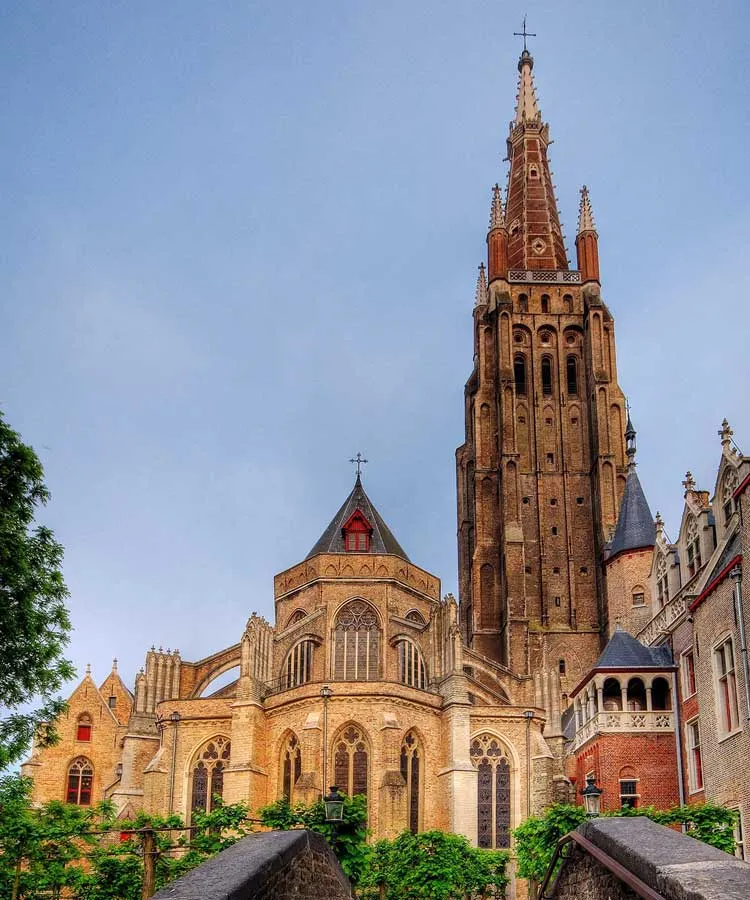
Introduction
The Church of Our Lady (Dutch: Onze-Lieve-Vrouwekerk) in Bruges, Belgium, dates mainly from the 13th, 14th and 15th centuries. This church is essentially “a monument to the wealth, sophistication, taste, and devotion of this most Catholic city, whose history and faith stand today celebrated in this wonderful building” and it is one of the oldest places of worship in Bruges, and a tourist attraction. Until the end of the Ancien Régime, it was a collegiate church with a provost and a chapter of canons, later a decanal church.
The Church of Our Lady in Bruges, Belgium, is a magnificent medieval church which was constructed over a period of at least two hundred years, starting in the 13th century.
The 115.6-metre-high, fully brick-built tower dominates the Bruges cityscape. The Church of Our Lady, one of the tallest buildings in Belgium, is the second tallest brick building in the world (after the 130.6-metre-tall St. Martin’s Church in Landshut, Germany).
The church demonstrates the Gothic style in the prominent Flying buttresses on the exterior which were constructed in the 1270s and 80s. The nave contains cross-vaults and black and white tiled flooring. The interior demonstrates the heavily ornamented Baroque style in the side aisles and chancel. One of the chapels in the church was created in 1482 for a wealthy man named Lodewijk van Gruuthuse, as his personal worship area.
It is a recognized parish church within Bruges and has been part of the parish federation of Saint Donatian since the early 21st century. Since the 1980s it also functions as a tourist ‘reception church’. Since 2019, the church has been included in the umbrella organization Musea Brugge.
Today, visitors to the Church of Our Lady can walk up the tight circular staircase for a remarkable view of the city centre square. Among the other attractions to be found within the church are the impressive 16th century tombs of Charles the Bold and his daughter, Mary of Burgundy, who ruled the Low Countries until her death in 1482, at the age of just 25, after a fall from her horse.
Perhaps the most famous element of the Church of Our Lady in Bruges is the white marble sculpture of the Madonna and Child created by Michelangelo in approximately 1504. It is one of just a handful of Michelangelo’s sculptures to be found outside Italy.
History of Church of Our Lady of Bruges
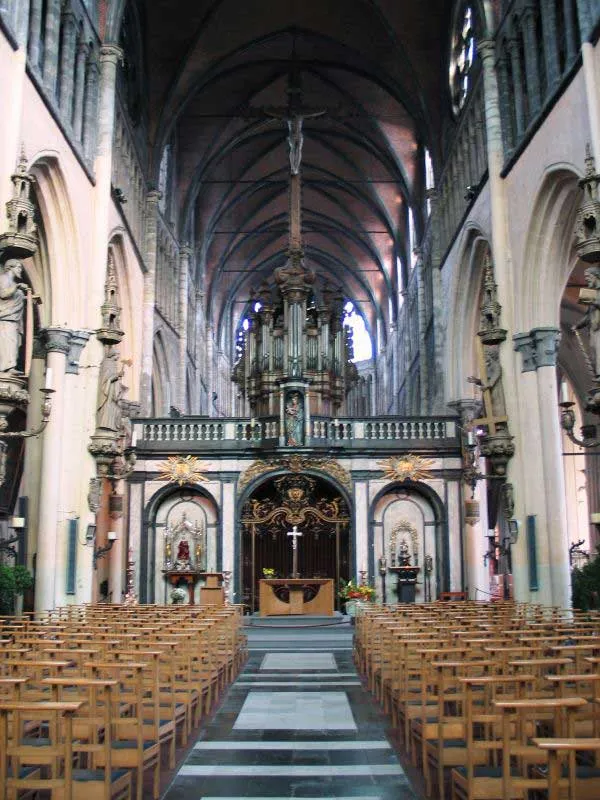
The first church on this site, a Carolingian chapel, dates from about 875. In the church’s archives, the foundation is dated to the year 741 and attributed to Boniface, but this claim is doubtful, as the oldest patronymicum goes back to his companion Hilarius. The chapel was founded, according to the current thesis, as a daughter church of the Sint-Maartenskerk in Sijsele, which in turn was owned by the Dom van Utrecht. In 1116 the chapel separated from Sijsele and became the main church of an independent parish. Presumably for this reason the structure was rebuilt and expanded under Charles the Good.
From about 1230, the construction of the current church was started. The oldest part, the nave, was built in Tournai stone, in the typical Scheldt Gothic style. The influence of Scheldt Gothic is also recognizable on the front and west facade, with the two typical stair turrets and the use of blue stone. The choir area and apse, built between 1270 and 1280, exude classical French Gothic, but this one entirely in brick. In 1370 the northern beech was built and in 1450 the southern one. Around 1465, the Paradise Portal was built in Brabantine Gothic.
The tower of the Church of Our Lady is the tallest building in the city of Bruges. The first tower collapsed in 1163 and was rebuilt between about 1270 and 1340; the spire was added only in the 15th century and rebuilt in the 19th century. The use of brick is typical of the Coastal Gothic style. The church has five naves. In the middle of the nave, the rood screen, which consists of three parts, divides the church into two parts: the high choir and the nave. The apostle statues are from the 17th century.
Madonna of Bruges
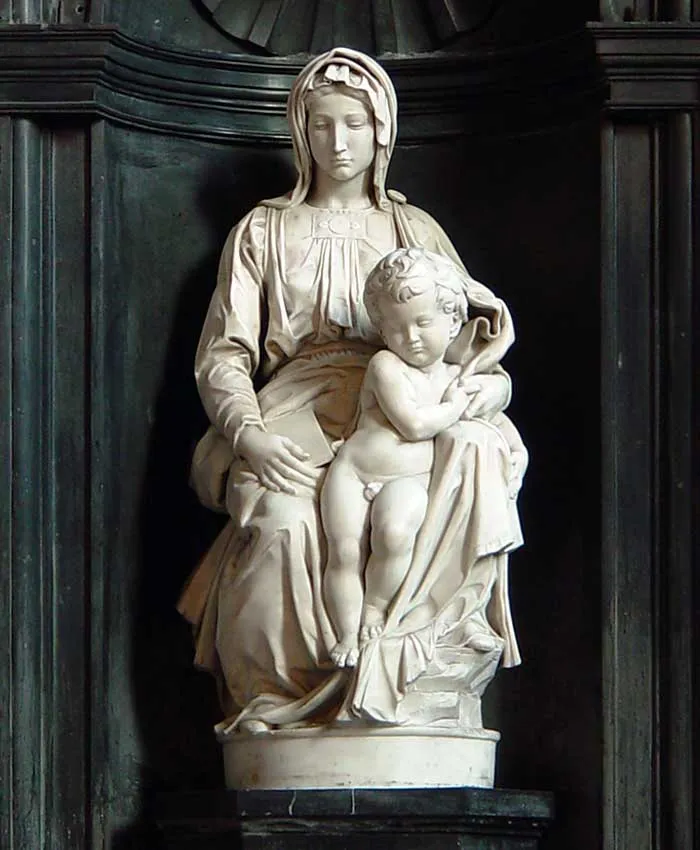
The Madonna of Bruges is a marble sculpture by Michelangelo of the Virgin and Child. Michelangelo’s depiction of the Madonna and Child differs significantly from earlier representations of the same subject, which tended to feature a pious Virgin smiling down on an infant held in her arms. Instead, Jesus stands upright, almost unsupported, only loosely restrained by Mary’s left hand, and appears to be about to step away from his mother.
Meanwhile, Mary does not cling to her son or even look at him, but gazes down and away. It is believed the work was originally intended for an altar piece. If this is so, then it would have been displayed facing slightly to the right and looking down. The early 16th-century sculpture also displays the High Renaissance Pyramid style frequently seen in the works of Leonardo da Vinci during the late 1400s.
Madonna and Child shares certain similarities with Michelangelo’s Pietà, which was completed shortly before – mainly, the chiaroscuro effect and movement of the drapery. The long, oval face of Mary is also reminiscent of the Pietà.
The work is also notable in that it was the first sculpture by Michelangelo to leave Italy during his lifetime. In 1504, it was bought by Giovanni and Alessandro Moscheroni (Mouscron), who were wealthy cloth merchants in Bruges, then one of the leading commercial cities in Europe. The sculpture was sold for 4,000 florins.
The sculpture was removed twice from Belgium after its initial arrival. The first was in 1794 after French Revolutionaries had conquered the Austrian Netherlands during the French Revolutionary Wars; the citizens of Bruges were ordered to ship it and several other valuable works of art to Paris. It was returned after Napoleon’s final defeat at Waterloo in 1815. The second removal was in 1944, during World War II, with the retreat of German soldiers, who smuggled the sculpture to Germany enveloped in mattresses in a Red Cross truck.
It was discovered a year later in Altaussee, Austria within a salt mine and again returned. It now sits in the Church of Our Lady in Bruges, Belgium. This is represented in the 2014 film The Monuments Men.
Tombs and Choir
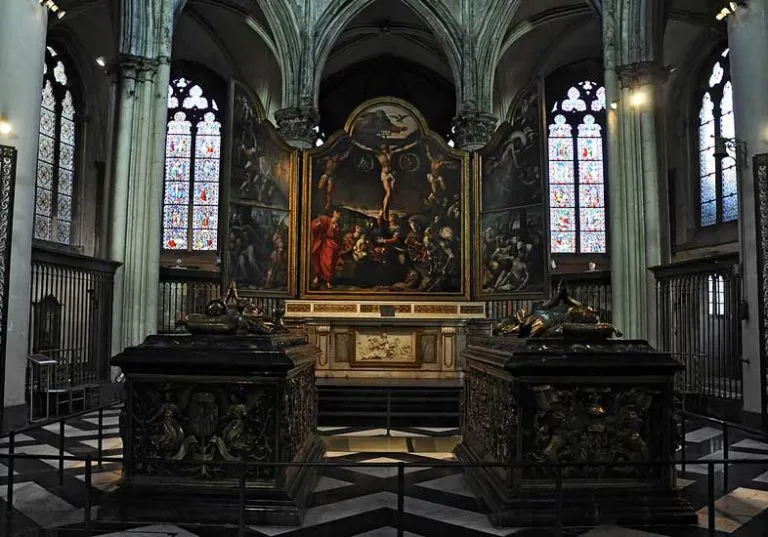
The church is known, among other things, because Mary of Burgundy is buried there. During archaeological research in 1979, her remains were identified. Only the tomb of her father, Karel de Stoute, is present here. His remains were transferred from France to Bruges by Emperor Charles V, a grandson of Mary. He was probably buried in the now-defunct Sint-Donaas Cathedral on the Burg. His corpse was never found. The tombs are located in the high choir of the church.
Above the high altar is a triptych by Margaret of Austria’s court painter, Bernard van Orley. It is a passion story with the crucifixion in the middle. At the foot of the altar, under the tombs, three richly painted tombs have been uncovered.
The lead coffin in one of the tombs (visible) contains the bones of Mary who died in Bruges in 1482. An inscription indicates that the heart of her son Philip the Fair, father of Charles V, is kept in a separate lead box.
The tomb of Mary and also the oldest, was designed by Jan Borman. Both monarchs are depicted in a recumbent position with folded hands, according to medieval custom. With open eyes they contemplate eternal life. At their feet, lion and dog act as symbols of masculine strength and feminine fidelity.
The face of Mary of Burgundy is delicately depicted, modeled after the death mask. Her crown adorned with jewels, her hands and her lush billowing cloak are a miniature work of art. The funerary monument is still completely Gothic in concept and spirit.
The tomb of Charles the Bold is half a century younger. The elaboration is part Gothic, part Renaissance. The lines are much tighter, but the armor is artfully and detailed. Both black sarcophagi have memorial plaques on the front and on the side walls you can see the enameled family shields of the ancestors.
Thirty coats of arms of Knights of the Golden Fleece hang above the choir stalls . The first shield on the left is that of Charles the Bold, directly opposite that of his brother-in-law Edward IV of England. The coats of arms recall the chapter of the Order of the Golden Fleece held in this church in 1468.
Mary and Child by Michelangelo
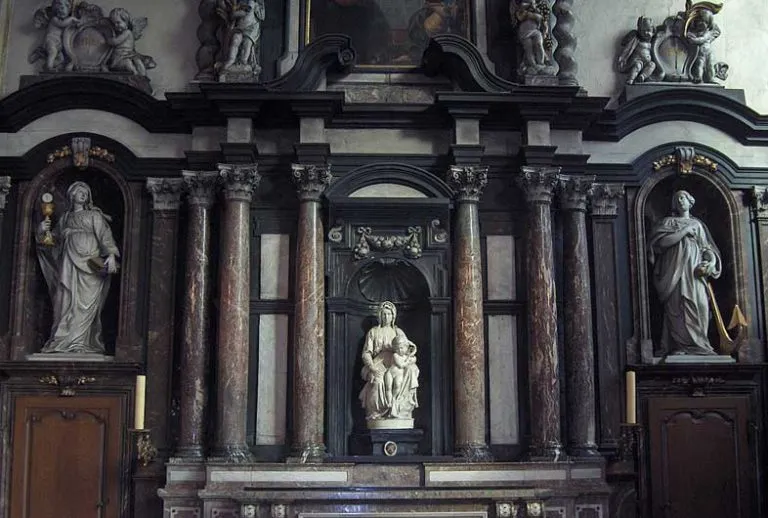
Michelangelo ‘s world-famous work, Madonna and Child, intended for the Piccolomini altar of Siena Cathedral, is one of the most important works of art preserved in the Church of Our Lady. It was purchased in Italy by the Bruges merchant Jan van Moeskroen (Giovanni di Moscerone) and donated to the church in 1514. The donor’s family tomb is located at the foot of the altar, in front of the statue.
The statue was removed in 1794 by the French occupiers and in 1944 by the German occupiers, but could always be returned to Bruges.
Lanchals Chapel
Pieter Lanchals (1440-1488) was the bailiff of Bruges who was beheaded by the citizens of Bruges for his loyalty to Burgundy and to Maximilian of Austria. His head was exhibited at the Gentpoort. His funerary monument was partly preserved in the Onze-Lieve-Vrouwekerk.
According to a legend that originated in the 19th century, Emperor Maximilian I, husband of Mary of Burgundy, ordered the city to maintain 52 long -necked swans for eternity and to let them swim in the canals.
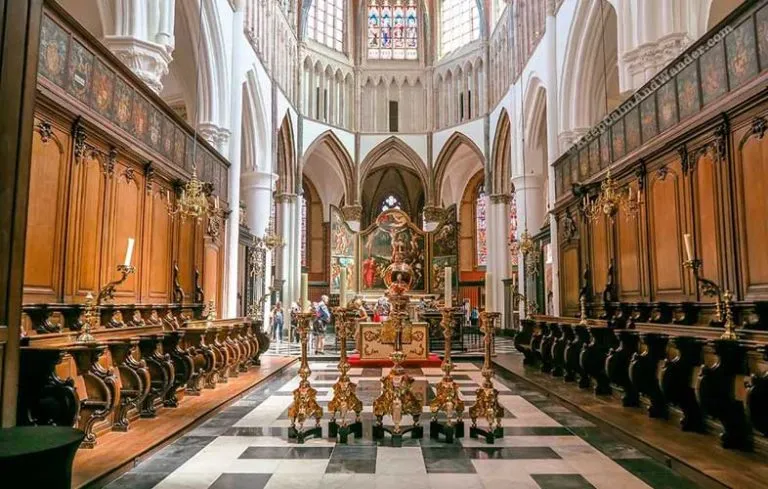
Burials
In the choir space behind the high altar are the tombs of Charles the Bold, last Valois Duke of Burgundy, and that of his daughter, the duchess Mary. The gilded bronze effigies of both father and daughter repose at full length on polished slabs of black stone. Both are crowned, and Charles is represented in full armor and wearing the decoration of the Order of the Golden Fleece. The dress and ornamentation of the bronzed Mary is consistent with the Gothic style, and around the sides of the stone is a genealogy.
There is glass over the tomb opening so the frescoes on the walls are visible from above, with Jan Borman being the creator of the tomb. The English founder of the convent at Antwerp, Mary Lovel, was buried by the high altar in 1628. She died here whilst trying to establish another convent in the city.
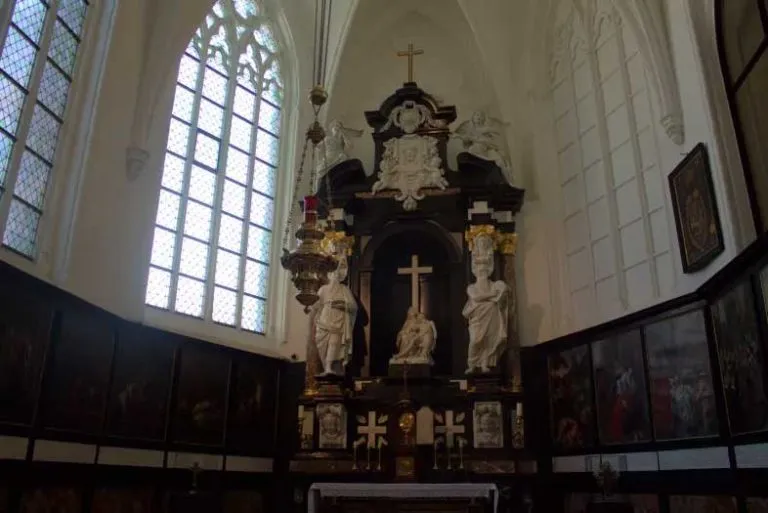
Feast Day – 21st March
Annual Feast Day of Our Lady of Bruges celebrated on 21st March.
Mass Time
Weekdays
Sundays
Church Visiting Time
Contact Info
Mariastraat, 8000 Brugge, Belgium
Phone No.
Tel : +32 50 34 53 14
Accommodations
How to reach the Church
Ostend–Bruges International Airport, commonly known simply as Ostend Airport in southwest of Ostend, West Flanders in the Flemish Region of Belgium, the city centre of Bruges is the nearby Airport to the Church.
Brugge Transit Stop in Bruges, Belgium is the nearby Train Station to the Church.

